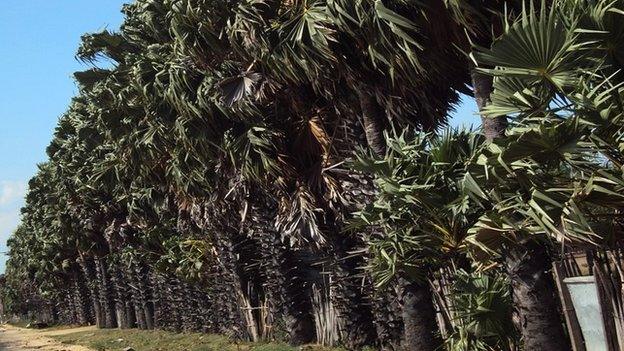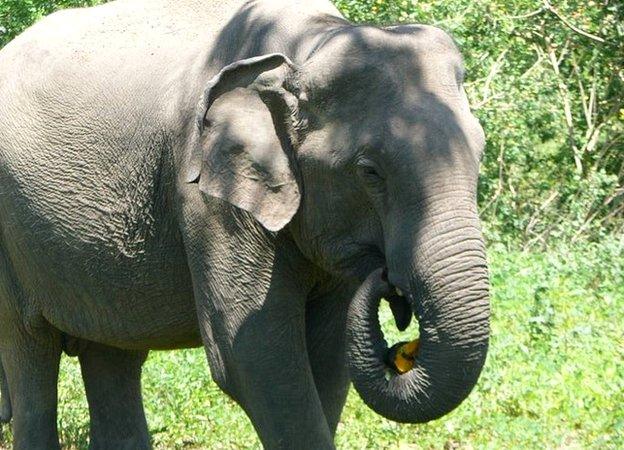Fence of trees to stem human-elephant conflict
- Published

The natural fence could offer a sustainable solution to the problem
An unprecedented drought in Sri Lanka is exacerbating the longstanding potential for conflict between humans an elephants, reports suggest.
But a "fence" of palmyra trees is starting to yield success.
With forest vegetation and water holes vanishing, hundreds of elephants are reported to have approached settlements in search of food and water.
Sri Lanka has been dealing with the issue for years, and it has led to the deaths of people and elephants.
An average of 50 humans and 160 elephant deaths has occurred annually, statistics reveal.
The palmyra fence is an attempt to find a sustainable solution to human-elephant conflict.
Researchers have told the BBC that the fence has been successfully tested in Sri Lanka.
The option is cost effective, durable and sustainable, Ranasinghe Perera, head of the programme Practical Action in Sri Lanka, told the BBC Tamil Service.
"The initial cost of planting the Palmyra fence is very little, it has no maintenance cost after three years and survives for more than 100 years," he said.

The trees also provide fruit for the elephants
According to the researchers, this is totally based on the indigenous knowledge of the local people and has been developed into a systematic methodology by them.
Palmyra trees were grown in a zig-zag fashion with a five foot gap in between them and with eight feet gaps between the rows.
This effectively creates a forty foot barrier between humans and elephants.
As a tree, palmyra has proven to be sturdy and impregnable, Laffir Mohammed, the project director behind the four pilot projects pointed out.
The trees' sharp edges and the fronds with saw like teeth keep the elephants away.
The researchers say that the fence is also an environmentally friendly option.
However Mr Perera said it takes a minimum of eight years for the palmyra trees to grow and until then, the existing mechanism of either a barbed wire or electrical fence will need to remain.
"The effective period of an electrified fence is 10-12 years, by which time the palmyra trees would have grown sufficiently, providing an effective, sustainable barrier blocking the elephants from entering human settlement areas," he told the BBC.

The sharp edges keep elephants away
The cost of planting and maintaining a palmyra fence is about one-fifth the cost of an electric fence and money spent on electricity would be saved.
Another organisation involved in the project, Janathakshan, says that the tree-based fence not only stops elephants, but also generates income for communities living on the edge of the forest.
One kilometre of palmyra fence can provide a minimum of 270 metric tonnes of fruit for the wild elephants and adds around 2,500 trees to the vegetation based on the results of the pilot project implemented in four regions of the country.
But researchers involved in the pilot project accepted that the low germination rate of palmyra seeds (of around 20-30%) posed a potential obstacle.
However, they are confident that the problem can be overcome by developing palmyra nurseries and planting seedlings instead of seeds.
The researchers say they are now in the process of showing members of the communities around the pilot project sites in an attempt to popularise the scheme.
The International Elephant Fund has provided some resources to the project to test its effectiveness.
Work is also underway to a develop new hybrid varieties of palmyra with higher germination rates and longer life spans.
Either way, the effectiveness of the fence should be known in the next few years.